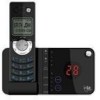GE 28118FE1 User Guide - Page 30
Receiving CID Records, Storing CID Records In CID Memory, Reviewing CID Records, Dialing a CID
 |
UPC - 044319701685
View all GE 28118FE1 manuals
Add to My Manuals
Save this manual to your list of manuals |
Page 30 highlights
Receiving CID Records When you receive a call, the Caller ID information is transmitted between the first and second ring. The Caller ID information appears on the display while the phone rings, giving you a chance to monitor the information and decide whether or not to answer the call. Storing CID Records (In CID Memory) If you are not at home or cannot answer, your telephone's Caller ID memory stores the data for the 40 most recent calls you received so you can see who called while you were unavailable. When the 41st call is received, the oldest Caller ID record (1st call) is automatically deleted. You may review the stored information at any time. Calls received since your last review show as NEW in the display. Calls that have not been previously reviewed but were received from the same number more than once show as REPT in the display. Reviewing CID Records As calls are received and stored, the display is updated to let you know how many calls have been received. To scroll CID records: 1. Make sure the phone is OFF (not in talk mode). 2. Press the vol/CID ( 5 ) button to review the newest CID record. 3. Press the vol/CID ( 6 ) button to review the oldest CID record first. Dialing a CID Number 1. Make sure the phone is OFF (not in TALK mode). 2. Use the vol/CID ( 6 or 5) button to display the desired record. 3. Press the talk or speaker button. The number dials automatically. NOTE: Depending on (a) how the incoming caller's phone number is formatted when it is received, and (b) whether or not you previously preprogrammed your local area code into the set up menu, you may need to adjust the format of the incoming caller's stored phone number before making the call, press the redial/format button to adjust the number, and try again. 30















